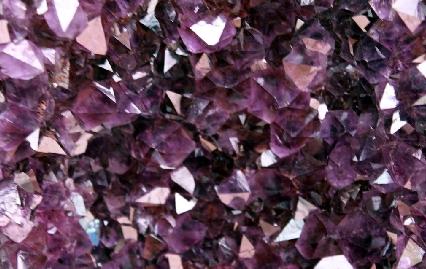 Crystal is one of people's favorite jewelry, is a colorless and transparent quartz crystal minerals. Its main chemistry is silicon dioxide, which is the same thing as ordinary sand. When the silicon dioxide crystal is perfect, it is crystal; silica gel dehydration is agate; silica hydrous colloid becomes an opal; when the silica crystal grain is less than a few microns, it is composed of chalcedony, vermiculite, secondary Quartzite.
Crystal is one of people's favorite jewelry, is a colorless and transparent quartz crystal minerals. Its main chemistry is silicon dioxide, which is the same thing as ordinary sand. When the silicon dioxide crystal is perfect, it is crystal; silica gel dehydration is agate; silica hydrous colloid becomes an opal; when the silica crystal grain is less than a few microns, it is composed of chalcedony, vermiculite, secondary Quartzite. Perfect crystal crystal is a hexagonal system, often hexagonal prism, the column is a tip or two tips, a number of long cylinders linked together, known as Crystal family, beautiful and spectacular. Silica crystals are incomplete and their shapes can vary. When you go to Hainan Crystal Exhibition Hall, you can see an eye-opener: In addition to the common long columnar shape, there are also sword-like swords, some like a plate, some like a short column, and some like a double cone. Some are as small as fingers, others as large as rocks; some are less than two and some weigh more than 300 kilograms.
Why can crystal stand up to the general beat? This is because it has a strong "bone", known as the hardness of gemstones, hardness refers to the intensity of the resistance of the stone.
How to measure the hardness of crystal?
Long ago, the owner of the pawnshop used a hard tip or steel file to detect hardness on the inconspicuous facet of the crystal imitation that they believed to be suspicious. They scored on the face, leaving a bit of inconspicuous evidence. Remind other pawnmates to pay attention. Obviously this is one of the most primitive and cumbersome testing methods, which may lead to crystal damage.
In 1824, an Austrian mineralogist named Frisch Moss extracted 10 species from many minerals. Their relative hardness was measured through scientific experiments, and the hardness of the crystal was Mohs 7. Although later the National Bureau of Standards used and promoted the more scientific Knoop hardness tester, jewelers in many countries in the world are still accustomed to the Moh's hardness scale.
The hardness of the crystal is equivalent to that of a hard steel file. This makes the jewels such as crisp and fragile topaz, diamonds, opal stones, and emeralds dwarf.
Crystal cleavage: None.
Cleavage, commonly known as open up. Some gems (such as topaz and diamonds) will crack along a plane after they are struck, squeezed or collided by external forces. This property of gems is known as cleavage.
Crystal break: shell-like.
Break, mineralogy is called fracture. It means that the gemstone is under a certain external force and does not break in a certain crystal direction, but forms a broken surface. To put it another way, it is said that the rip of a gem can extend in any direction, instead of developing along cleavage.
Crystallized crystals often have good herringbone fractures with parallel ridges; in amethyst and heat-treated citrine, most of them are uneven to lamellar.
The proportion of crystal: 2.56-2.66 g/cm3.
This means that the weight of a certain volume of crystal is 2.56-2.66 times the weight of the same volume of water. Bulk crystals may have slightly higher densities.
Crystal streak: colorless.
Streaks, often called colors, are the result of the human eye's perception of a certain wavelength of light.
Crystal transparency is related to the quality and quantity of light passing through it. The transparent standard is that when the light is transparent to a piece or sheet of crystal with a thickness of 1 cm or more, the reflected image can be clearly seen. If the bottom image is not clear enough, but only the outline, then it will be translucent.
Crystal Gloss: Glass sheen. This is true on both the polished surface and the break.
Luster refers to an optical property of the gemstone surface that reflects light. Crystals do not reflect brilliant star-shaped stripes like the Star Sapphire and Star Gemstones, and they do not emit light blue wavelike brilliance like the moonstones, and they are not as colorful as opal stones.
Crystal refractive index: 1.544-1.553, almost does not exceed this range.
The refractive index is the ratio of the sine of the incident angle to the sine of the refraction angle when the light penetrates into the gem crystal from the air and produces a refraction phenomenon.
Crystal refractive index: 0.009 (maximum), this value is very stable.
Crystal light characteristics: Axial crystal positive light.
Crystal dispersion: 0.013.
Dispersion means that the refractive index of a gemstone varies with the illumination light. For example, a diamond refracts 2.405 for red light, 2.427 for green light, and 2.449 for violet light.
The melting point of the crystal is 1713 degrees Celsius. Its heat-breakable properties were discovered during the experiment. Place the crystal in the flame of the flame burner. Unless it is well protected and slowly cools, the crystal will crack and crack. This spleen, the ancients have found out. Natural History> Remind: "Where the use of crystal utensils, hot water can not be used to note that the powder is cracked."
The other spleen of crystal is afraid that the alkali is not afraid of acid (except fluorohydrofluoric acid), which is determined by the characteristics of silicon oxide.
A gemstone like agate, when heated, rubbed, blown, or hit, often emits a special odor, reminiscent of garlic, horse meat, radish, and pineapple flavors. However, crystals are not Odor.
Sapphire Window As Phone Cover
Optical Glass Window,Sapphire Window For Optics,Hard Sapphire Glass Window,Customized Optical Glass Window
ShanXiZhongJuJingKe Semiconductor Co., Ltd , https://www.sxzjjk.com